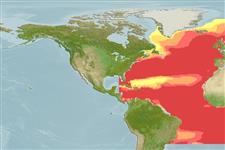Environment: milieu / climate zone / depth range / distribution range
Écologie
marin bathypélagique; profondeur 100 - 1800 m (Ref. 87004), usually 100 - 1100 m (Ref. 87004). Subtropical; 75°N - 25°S, 85°W - 0°W
Distribution
Pays | Zones FAO | Écosystèmes | Occurrences | Point map | Introductions | Faunafri
Atlantic Ocean: From Iceland to Brazil and Guinea Gulf, from Caribbean to West Africa.
Taille / Poids / Âge
Maturity: Lm ? range ? - ? cm
Max length : 11.0 cm SL mâle / non sexé; (Ref. 123983)
Description synthétique
Clés d'identification | Morphologie | Morphométrie
Épines dorsales (Total) : 7 - 8; Rayons mous dorsaux (Total) : 10 - 11; Épines anales: 3; Rayons mous anaux: 7 - 8; Vertèbres: 24 - 26. 3 scale rows under the D2 origin down to the lateral line, 10-11 (rarely 12-13) in total. 14-15 pelvic fin rays, rarely 16.
Individuals 7.5 cm SL and longer mostly occur in the boreal areas, while those less than this the length occur in the tropical areas (Ref. 87004). Maximum length reported in Ref. 87004: 11 cm TL.
Life cycle and mating behavior
Maturities | Reproduction | Spawnings | Egg(s) | Fecundities | Larves
Santos, R.S., F.M. Porteiro and J.P. Barreiros, 1997. Marine fishes of the Azores: annotated checklist and bibliography. Bulletin of the University of Azores. Supplement 1. 244 p. (Ref. 35204)
Statut dans la liste rouge de l'IUCN (Ref. 130435)
Menace pour l'homme
Harmless
Utilisations par l'homme
Outils
Articles particuliers
Télécharger en XML
Sources Internet
Estimates based on models
Preferred temperature (Ref.
123201): 1.7 - 18.6, mean 7.7 °C (based on 1396 cells).
Phylogenetic diversity index (Ref.
82804): PD
50 = 0.5176 [Uniqueness, from 0.5 = low to 2.0 = high].
Bayesian length-weight: a=0.01000 (0.00244 - 0.04107), b=3.04 (2.81 - 3.27), in cm total length, based on all LWR estimates for this body shape (Ref.
93245).
Niveau trophique (Ref.
69278): 3.4 ±0.4 se; based on size and trophs of closest relatives
Résilience (Ref.
120179): Milieu, temps minimum de doublement de population : 1,4 à 4,4 années (Fecundity assumed < 1000).
Fishing Vulnerability (Ref.
59153): Low vulnerability (10 of 100).
